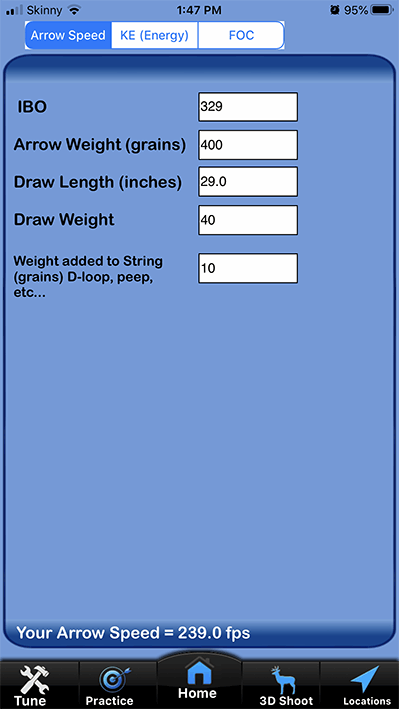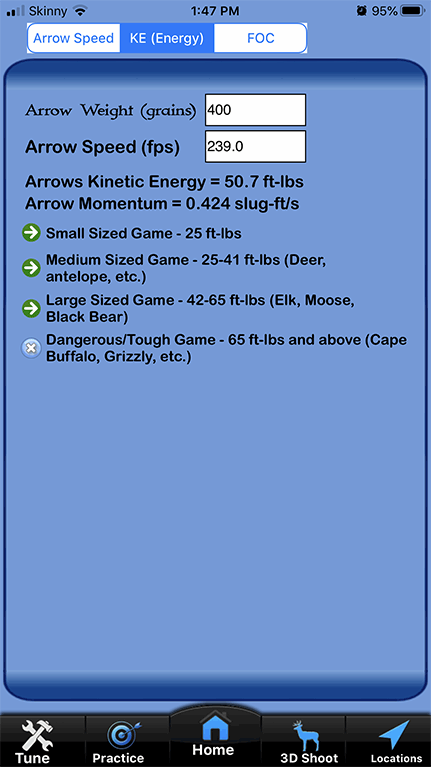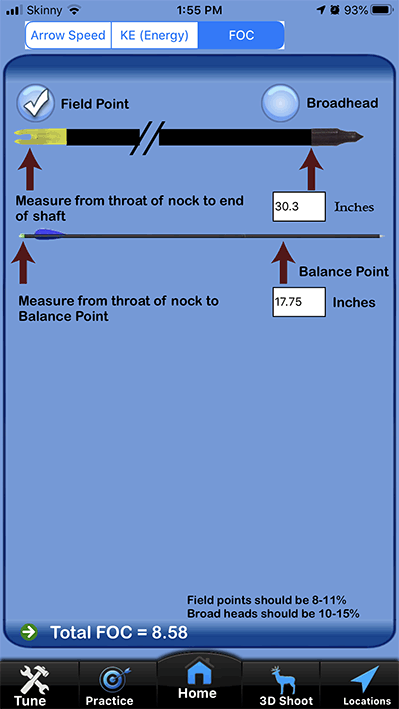The below is an interesting article on speed vis momentum...
https://www.qdma.com/momentum-beats-...al-arrow-hits/
Momentum Beats Speed for Lethal Arrow Hits
June 18, 2013 | By Bill Badgley
Lethal shots without wounding deer are every ethical hunter’s top priority, and shot placement and an understanding of anatomy are paramount. However, momentum should be the most important part of arrow selection if we want to achieve every ethical bowhunter’s top priority.
The archery industry and too many bowhunters have a fascination with the speed of an arrow. If 3-D shooting is your only quest, speed is the major factor, and you don’t need to be concerned with momentum. If you are a deer hunter striving for quick, clean, humane kills, then it’s all about momentum.
Much has been written about this subject, but little of it seems to be put into practice. I’m sure someone out there will argue that they kill every deer they shoot at with their ultra-light, super-fast arrows. And I’m also sure someone out there could kill a deer with a jackknife. I just want hunters to understand the physics of momentum and be aware of this critical aspect of bowhunting.
In simple terms, speed is what gets an arrow to its target. Momentum is what happens after it hits the target.
Yes, speed figures into the equation of momentum, but weight has more relevance than speed in the momentum equation. Kinetic energy is a firearms equation and not relevant to archery. Here are a couple non-hunting examples to help you grasp what momentum is.
• A baseball going 100 mph has less momentum than a bowling ball going 10 mph.
• A basketball coming down a hill at 20 mph is easily stopped by a healthy adult, but that same adult would do well to get out of the way of a Cadillac rolling down the same hill at 5 mph.
The same is true for arrows. A heavy arrow has greater momentum and it is much harder to stop after it meets resistance. That can be especially important with a marginal hit or a hit that encounters bone.
Why then do we strive for speed by going to lighter and lighter arrows? I think because we have been convinced that speed means power and flat trajectory. Both are true to a point, but for bowhunting we need to go a step further and ask “Compared to what?” If more power means the ability to penetrate after meeting resistance, then it’s not completely true that speed produces power. If flatter trajectory means like a bullet, then it’s not true at all. The fastest hunting arrows are extremely slow compared to even the slowest bullet. These fast arrows are much slower than the speed of sound, which is 1,085 feet per second. Let the 3-D and firearms folks have speed; we bowhunters need to concentrate on momentum.
The good news is we can use all this modern bow technology the industry is hyping as speed and convert it to the more important task of momentum. All that’s required is that we shoot a heavier arrow. Sure, speed will go down, and yes trajectory will not be as flat. However what we give up is minor compared to what we gain in quick, humane killing power. For those of you who are shooting high-poundage bows, let’s say above 65 pounds, even the lighter arrows should have enough momentum for whitetails at reasonable distances, however heavier arrows will perform much better for you at longer distances, on marginal hits, and when you hit bone. You may also want to recalculate if you plan a hunt for moose, elk, or bear. Remember, momentum is diminishing as an arrow travels. And it diminishes much faster for light arrows than it does for heavy ones. Don’t blame me, it’s simple physics.
As you can see, this fast-arrow thing is luring us into a false sense of security. Because we can hit a target farther out, we do it, even though the light arrow that allowed the easier shot may not have the momentum to kill quickly and humanely. Hitting an animal at 40 or 50 yards is no consolation if it runs away with only one punctured lung. Where we really get into trouble is with the bows of lighter poundage, say below 60 pounds.
This article is mostly about the killing power of heavier vs. lighter arrows, but there are other advantages as well to the heavier arrow. The shot will be quieter, more forgiving, and less prone to deflection or wind drift. Yes, a well-placed light arrow is certainly better than a poorly placed heavy one. However, all things being equal, the heavy ones allow for a greater margin of error.
Here are some guidelines if you want to quickly kill deer and track wounded ones less.
Only go after the “speed you need.” Let the rest of the bow’s power be converted to momentum. Here in the northeast we rarely shoot at deer beyond 20 yards. When we teach the Quality Deer Hunter course (a 4-part training course focusing on fine-tuning archery and firearms equipment as well as anatomy and shot placement) , we ask our participants to fill out a questionnaire, and one of the questions is, “What is the average distance deer are from you when you shoot?” The answer for several years of data is about 16 yards. My own average is closer to 12. So, the speed we need is most likely far less than what we have. Again, I’m sure we have this speed because we have been led to believe that speed is power. Hopefully you have already been convinced that it’s not true. So if my 64-lb. bow shoots a 520-grain arrow at 220 fps (very slow by today’s standards) I can sight it in to hit dead on at 16 to 17 yards and not have to worry about any other sight pins from 0 to 20 yards. The trajectory will be slightly higher closer up and slightly lower further back, but not enough to cause a miss at the 8- to 9-inch vital area we are shooting at. With this setup I can be confident of clean pass-through shots, even if I shoot a sharp angle where the arrow enters behind the last rib and exits in front of the off-side leg. Please don’t ever try this shot with overly light arrows or you will be tracking for a long time. What should have been a dead-in-10-seconds deer will become a maybe-dead-in-several-hours one.
We all know the exit hole is more conducive to retrieving a deer than the entrance hole. Momentum is your best friend if you want exit holes nearly every time.
For those of you worried about the deer jumping the string because of slow arrows, let me assure you at 12 yards even 150 fps will get an arrow to the deer before they can react. Where we get into trouble with deer jumping the string because of “arrow noise” is when the distance gets beyond 20 yards. Remember, sound is traveling 1,085 fps, so even your super-fast 300 fps arrows are not going to beat a deer’s ears at longer distances. Movement and bow noises before the shot are the more likely culprits at the shorter distances.
Perhaps someone someday will be able to tell us how much momentum we need to cleanly kill any given game animal at any given distance. Until that day let me leave you with my unscientific advice that has served me well for whitetails. I’ll start with the premise that the bow setup I’m using leaves nothing to be desired. It is simple, lethal, has never let me down, and has killed 43 deer to date. Based on that, let’s just say we need our arrows’ total weight to be about 8 grains per pound of draw weight if our bow is in the 60-lb. range. If you are shooting a bow in the 70-lb. range, we can drop that back to 6 grains per pound of draw weight. And lastly and most importantly you might want to think about 10 grains of arrow weight per pound of draw weight if you get down in the 45- to 50-lb. range. Yes these heavier arrows out of these low-poundage bows will be slower, but faster arrows that wound are of little use to an ethical hunter. If that means the hunters with lower-poundage bows can only shoot out to 15 yards, then so be it. I have a feeling, however, that even these slower arrows could be sighted in for a couple of inches high at 10 yards and still be in an 8-inch vital zone at 20 yards. At least when these arrows hit the deer they have a decent and more lethal amount of momentum.
Let’s review my advice:
6 grains of arrow weight per pound of draw weight for bows in the 70-lb. range
8 grains of arrow weight per pound of draw weight for bows in the 60-lb. range
10 grains of arrow weight per pound of draw weight for bows in the 50-lb. range
In summary, set up your archery equipment understanding that momentum is more important than speed. If you need more speed, it should come from a higher poundage bow, not a lighter arrow.
Welcome guest, is this your first visit? Create Account now to join.
Welcome to the NZ Hunting and Shooting Forums.
Search Forums
User Tag List
+ Reply to Thread
Results 1 to 13 of 13
Thread: Speed for Arrows
-
08-07-2020, 02:23 PM #1
Speed for Arrows
-
-
08-07-2020, 03:11 PM #2
And having some more time on my hands I got an app ArcheryPal on my iPhone and found some interesting things.
1st Arrow Speed -I estimated my arrow weight at 400 grains
turns out to be surprisingly similar to the measured rough and ready speed I got in the thread "My Bow's FPS"

And the Kinetic Energy

And FOC (arrow front of centre - balance)

So it looks like, I'm off to hunt me some Bar - (Yokel for Bear)
-
08-07-2020, 04:24 PM #3
The arrow speed calculator that I use says that your setup is doing 249fps and 55.06 kinetic energy
FALL IN LOVE WITH THE NUMBERS , NOT THE IDEA
-
08-07-2020, 06:02 PM #4
That's interesting, can I have a link to it? or name if it, so I can see?
-
08-07-2020, 06:55 PM #5
you know I had a discussion on this with a couple of very good bowhunters some 35ish years ago....the speed thing was just coming into fashion....crossbows were brought up......it doesnt matter how fast you throw a feather ,when it hits its still a feather...now a playing dart is a completely different kettle of fish...Ive always wondered how a sloid fibreglass arrow made out of the thinner electric fence poles would go.....the discussion all those years ago started as chap was telling me how he had to let a big stag go as only had neck in view.....a heavy solid arrow SHOULDVE had enough to punch into spine and a near miss would still cut the major blood vessels was my thinking at the time and hasnt really changed... I can vividly recal a red hind at about 100 yards that got a 30/06 150grn through neck...just too low..she got all staggery and turned around..I gave it a 130grn from poohseventy also in neck..same result...she staggered a bit then fell over...when we dressed her out our bullets paths were 2" apart going in opposite directions and both were only an inch low to hit bone..we in effect had cut her throat....
back to fibreglass fence poles...more than one cockie has come to grief after chucking one at a dog or sheep and they have hit end on....
-
08-07-2020, 08:39 PM #6FALL IN LOVE WITH THE NUMBERS , NOT THE IDEA
-
08-07-2020, 10:06 PM #7
@Ground Control, thanks for that, very useful looking and an additional source of info

-
07-09-2020, 05:07 PM #8Member

- Join Date
- Sep 2020
- Location
- Hutt Valley
- Posts
- 60
This is a great video on FOC and momentum:
https://www.youtube.com/watch?v=mlT4WzCRPIQ
(Guy's got attitude, but the science is solid)Last edited by Remote; 07-09-2020 at 05:15 PM.
-
08-09-2020, 11:09 AM #9Member

- Join Date
- Feb 2020
- Location
- Scotland
- Posts
- 1,049
Draw length has not been mentioned so far...
Critical factor here, and I am referring to a person's correct draw length (DL) with good technique not what the bow is set to.
If you look at an extreme example, guys like John Dudley (31.5+" DL) and Tim Gillingham (33" DL) who are absolute monsters (both over or around 6ft 4) they have a massive advantage over someone with a 28" DL. They will have more stored energy at their draw length in a 60lb bow vs a 28" DL with an 80 lb bow... yet they will be running around 70lbs!
This advantage is extended by the use of an overdraw arrow rest and an arrow cut short (Tim G cuts his hunting arrows to 28", let that sink in!), so we are talking about a whole lump of potential energy here.
The key is a balance between arrow speed and weight (think ballistics, light and fast vs heavy but slow). There is a balance to be struck and the final figures are ultimately limited by your build, if you can make 70lbs comfortably then that is a realistic target. I shot a 60lb bow for 5 years nearly every week and was very lucky to avoid major injury.
Theory is all good until the rubber hits the road, always go for comfort and consistency over big theoretical numbers. People have killed the big 5 in Africa with modern compound bows.
-
08-09-2020, 08:23 PM #10
good post....I have 30 and 31" arrows...the 30" is easier to use for longer time....that little bit extra makes huge difference (50lb recurve)
when drawing to lips/end of nose I still have 3" of arrow out front...by drawing to point of jaw,I get full draw....
-
08-09-2020, 08:58 PM #11Member

- Join Date
- Feb 2020
- Location
- Scotland
- Posts
- 1,049
Another factor is GPI (grains per inch) of your arrow.
People often cite light weight as a benefit of carbon arrows, but if you look at the top flight carbon arrows they will have a smaller outer diameter yet higher GPI when compared to cheaper carbon shafts.
What you want is a high GPI in a small diameter, which cuts wind drift significantly yet delivers/retains more energy on impact.
Cutting the arrow as short as possible and using an overdraw on a compound bow is done for a few reasons:
1- Stiffen the arrow shaft, a shorter shaft is stiffer, so if you can get away with a slightly lighter spine arrow cut short you are going to get better velocities (on a tuning front, it is impossible to have too stiff of an arrow shaft on a compound, too heavy? - yes too stiff? no!)
2- Effectively shortens your brace height- think about the distance the arrow has to travel between the end point of the powerstroke of the cams (where the string is at rest) and the arrow rest. Reducing this distance has a similar effect to a firearm with a shorter locktime, but in the case of bows you get a little more speed as well.
However, do all of the above with a shit ton of caution. If you shoot your wrist or blow up an arrow into your bow arm it's your own fault.
Yet some people fixate on how many grains they can stick on the end of an arrow... Seen better trajectory at a caber toss!
-
08-09-2020, 09:07 PM #12
funny that isnt it...poke extra weight on front yet get all anul about lightest possible shaft....
-
08-09-2020, 09:11 PM #13
Ive managed to get 2 of my carbon arrows into a stage where I wont use them....graphic photos of blown apart arrows abound.... so gone back to the 5 old alloy ones...have looked but havent yet found fibreglass arrows that will take points....seems like logical way to go to me.my accuracy is poor so range will have to be short,therefore slow arrow speed isnt issue..... heavy DURABLE arrow would be ideal...now to find some cheaply LOL.
Similar Threads
-
Glowing arrows
By Dama dama in forum ArcheryReplies: 18Last Post: 25-10-2017, 12:58 PM -
Arrows
By Ash123 in forum ArcheryReplies: 0Last Post: 30-12-2015, 03:36 PM -
Crafting Arrows
By seandundee in forum ArcheryReplies: 20Last Post: 05-04-2015, 10:12 AM
Tags for this Thread
Welcome to NZ Hunting and Shooting Forums! We see you're new here, or arn't logged in. Create an account, and Login for full access including our FREE BUY and SELL section Register NOW!!





 1Likes
1Likes LinkBack URL
LinkBack URL About LinkBacks
About LinkBacks



 Reply With Quote
Reply With Quote


Bookmarks